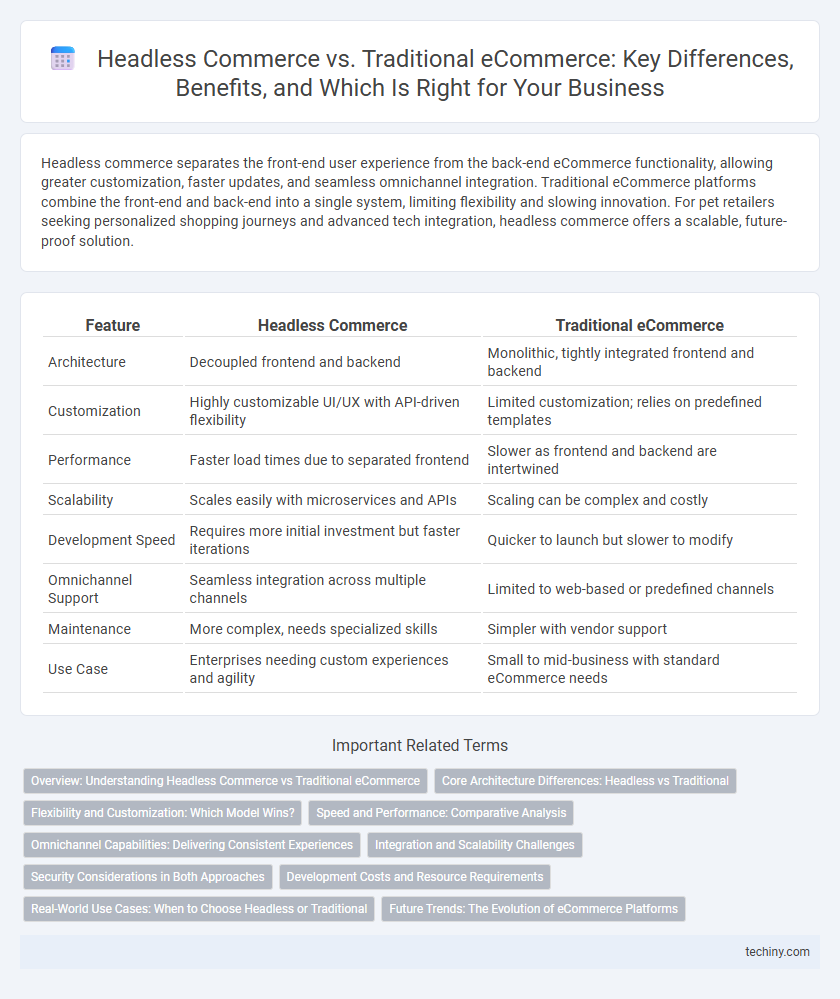Headless commerce separates the front-end user experience from the back-end eCommerce functionality, allowing greater customization, faster updates, and seamless omnichannel integration. Traditional eCommerce platforms combine the front-end and back-end into a single system, limiting flexibility and slowing innovation. For pet retailers seeking personalized shopping journeys and advanced tech integration, headless commerce offers a scalable, future-proof solution.
Table of Comparison
| Feature | Headless Commerce | Traditional eCommerce |
|---|---|---|
| Architecture | Decoupled frontend and backend | Monolithic, tightly integrated frontend and backend |
| Customization | Highly customizable UI/UX with API-driven flexibility | Limited customization; relies on predefined templates |
| Performance | Faster load times due to separated frontend | Slower as frontend and backend are intertwined |
| Scalability | Scales easily with microservices and APIs | Scaling can be complex and costly |
| Development Speed | Requires more initial investment but faster iterations | Quicker to launch but slower to modify |
| Omnichannel Support | Seamless integration across multiple channels | Limited to web-based or predefined channels |
| Maintenance | More complex, needs specialized skills | Simpler with vendor support |
| Use Case | Enterprises needing custom experiences and agility | Small to mid-business with standard eCommerce needs |
Overview: Understanding Headless Commerce vs Traditional eCommerce
Headless commerce separates the front-end presentation layer from the back-end eCommerce functionality, enabling greater flexibility in customizing user experiences across multiple channels. Traditional eCommerce platforms integrate both front-end and back-end tightly, which can limit scalability and the ability to innovate user interfaces. By decoupling the front-end, headless commerce supports faster updates, omnichannel consistency, and improved performance compared to traditional monolithic systems.
Core Architecture Differences: Headless vs Traditional
Headless commerce separates the front-end presentation layer from the back-end eCommerce functionality, enabling greater flexibility and faster customization using APIs to deliver content across multiple channels. Traditional eCommerce integrates the front-end and back-end within a single platform, limiting adaptability but simplifying development and maintenance. Headless architecture supports omnichannel strategies and scalability, while traditional platforms often prioritize monolithic, all-in-one solutions with less emphasis on modularity.
Flexibility and Customization: Which Model Wins?
Headless commerce offers superior flexibility and customization compared to traditional eCommerce by decoupling the front-end presentation layer from the back-end commerce functionality, enabling businesses to tailor unique user experiences across multiple channels. Traditional eCommerce platforms often restrict customization to pre-built templates and rigid frameworks, limiting scalability and rapid adaptation to new trends. Businesses seeking dynamic content delivery and seamless integration with various technologies benefit significantly from headless commerce's modular architecture.
Speed and Performance: Comparative Analysis
Headless commerce significantly outperforms traditional eCommerce platforms in speed and performance by decoupling the front-end presentation layer from the back-end system, enabling faster page load times and seamless content delivery across multiple channels. Traditional eCommerce architectures often suffer from slower response times due to tightly coupled systems and heavier monolithic designs that hinder scalability. The API-driven nature of headless commerce allows real-time data fetching and dynamic user experiences, resulting in improved site speed, reduced latency, and enhanced overall performance crucial for higher conversion rates.
Omnichannel Capabilities: Delivering Consistent Experiences
Headless commerce platforms enable seamless omnichannel experiences by decoupling the frontend from the backend, allowing consistent content and functionality across web, mobile, social media, and in-store channels. Traditional eCommerce systems often struggle with uniformity due to tightly integrated architectures that limit flexibility in delivering real-time updates and personalized interactions. Leveraging headless architecture enhances scalability and agility, ensuring brands provide cohesive customer journeys across diverse touchpoints.
Integration and Scalability Challenges
Headless commerce enables seamless integration with multiple front-end channels through API-driven architecture, overcoming the limitations of traditional eCommerce platforms that rely on monolithic systems. Scalability in headless commerce is enhanced by decoupling the front-end from back-end services, allowing businesses to independently update and scale components based on demand. Traditional eCommerce platforms face challenges in scaling and integration due to tightly coupled systems, which restrict flexibility and slow down time-to-market for new features.
Security Considerations in Both Approaches
Headless commerce separates the front-end presentation layer from the back-end eCommerce functionality, enhancing security by isolating user interfaces and reducing attack surfaces. Traditional eCommerce platforms integrate front-end and back-end tightly, potentially increasing vulnerability to data breaches due to their monolithic architecture. Implementing robust API security, encryption protocols, and continuous monitoring is crucial in headless commerce, while traditional platforms rely heavily on comprehensive platform security and regular patching to mitigate risks.
Development Costs and Resource Requirements
Headless commerce typically requires higher initial development costs due to the need for custom API integrations and specialized front-end frameworks, demanding skilled developers proficient in both back-end and front-end technologies. Traditional eCommerce platforms generally have lower upfront expenses, leveraging pre-built themes and plugins, but may incur higher ongoing costs for customization limitations and slower feature deployments. Resource requirements for headless commerce favor agile development teams capable of managing complex architectures, while traditional eCommerce suits smaller teams relying on out-of-the-box solutions.
Real-World Use Cases: When to Choose Headless or Traditional
Headless commerce excels in omnichannel retail environments, enabling brands like Nike to deliver seamless experiences across web, mobile, and IoT devices through flexible APIs. Traditional eCommerce platforms remain ideal for small businesses seeking straightforward, out-of-the-box solutions with integrated backend and frontend systems, as seen with many Shopify users. Enterprises prioritizing customization, scalability, and rapid innovation often adopt headless architectures, while those valuing simplicity and cost-effectiveness typically rely on traditional eCommerce models.
Future Trends: The Evolution of eCommerce Platforms
Headless commerce is redefining the future of eCommerce platforms by offering unmatched flexibility through API-driven architecture, enabling seamless integration with emerging technologies such as AI, IoT, and augmented reality. Traditional eCommerce systems, reliant on monolithic structures, struggle to keep pace with demands for personalized, omnichannel customer experiences and rapid content updates. The shift towards headless solutions accelerates digital transformation, empowering businesses to innovate faster and create scalable, adaptive storefronts that meet evolving consumer expectations.
Headless Commerce vs Traditional eCommerce Infographic

 techiny.com
techiny.com